In the impoundments and rivers, bait fishing seemed to fall by the wayside as fishing with lures gained increasing prominence.
Trolling and casting weren’t as boring as waiting for a nibble from a rod set on the ground or in a rod holder, but bait fishing still rates highly with lake fishers seeking success. A lot of keen anglers bob live yabbies or drown worms, crickets and large grasshoppers for cod, yellowbelly and bass, silver perch and even eels.
I got deeply into bait fishing when my kids came along. Many family fishers lean this way, especially when young kids toss $15-plus lures around and hang them in trees all day.
It gets expensive and pretty damn stressful, so when the kids come with me I rig them up with freshwater yabbies, mussels, worms, crickets and grasshoppers. At times they outfish me as I stroll along tossing lures.
A lot of anglers still know that a fresh yabby bobbed among the branches of a huge snag is a great way to pick up fish, especially big bass, golden perch and Murray cod.
And it’s a dirt-cheap way to fish. You don’t use anywhere near as much fuel as you would when trolling or moving around casting lures.
Most freshwater lakes all over NSW have a tackle shop or an individual that sells worms, yabbies and sometimes mudeyes, crickets and other bait to those who still know the effectiveness of bait fishing. The bait supplier often is not far from the water, usually on the way in to the dam or on a nearby back road – you will usually find someone.
With a bit of streamcraft, you can usually get your own bait and by inspiring your kids to forage for all the bait and fish with it, they’ll learn for life how to fish and will keep out of the treasure trove of lures in your tackle box.
Worms are the easiest. They’re in any home garden and your family can even help dig up a new garden bed while they’re gathering bait.
Freshwater mussels can be found in most streams and shallow areas of rivers. They are great bait but catfish and eels can sometimes be a problem by being the first fish to sniff them out. But any fish can be better than no fish, especially when kids are fishing.
You can also get the kids to run around with a plastic bug catcher or a fine scoop net and catch grasshoppers and crickets.
These baits can be suspended under floats in streams and lakes to appeal to surface fish like bass and yellowbelly, keeping the odds down on eels and catfish.
Silver perch love grasshoppers and a lot of anglers know this and will take time out to get really big grasshoppers for this reason. It is illegal to keep silvers in streams but check NSW Fisheries website for a list of dams where you are able to take five silvers over 25cm per day.
Gear for bait fishing can be most basic, starting off with a simple handline.
Rods, reels, a few floats and a stick or inventive rod holder are a bit further up the scale.
When shore-based, I always try to look for a rocky or clay bank or other clear area where there isn’t a heap of weed which will be a pest on every retrieve. However, some weed close by can be good because it does attract fish. Weed can hold shrimps and dragonfly larvae, as well as a host of other fish food.
Unfortunately carp are a problem in most impoundments and will snap up yabbies and worms. You might get three carp to every yellowbelly or bass but that’s the surprise when fishing with bait – you never know what will grab it next.
In many impoundments you aren’t allowed to fish around the dam wall because of spillways, water movement and other safety concerns. These no fishing zones are usually clearly marked. For instance, you can’t get close to the wall at Lake St Clair in the upper Hunter.
Where you are allowed to fish, these walls can fish well at times if you can get baits down rock walls. Fish that live in the walls can be enticed to come out of their holes and grab a bait.
Most lakes where fishing is permitted have some places where land-based fishing can take place. You can even drive right to the water’s edge at some impoundments while most dams have some great shore spots accessible on foot.
A boat opens an array of areas. The edges of weed beds, clearly visible submerged trees or underwater logs and trees you have located on a sounder can be great places, as can deep holes and drop-offs.
Some dams can be close to 100m deep so if you plan on fishing the bottom in these depths, you might need reels with a lot of line capacity. In some places close to the main wall, Glenbawn Dam can reach 40m-plus and getting baits down can be a problem. There’s no tidal flow but especially if there’s water coming in or out of the dam, there will be some movement.
Most boaties will bait up and send whatever they are using to the bottom, then reel up about a metre or two. This is normal, especially at the bases of trees, along drop-offs and just above weed.
Fish will sometimes snag you but eight times out of ten you will land them.
Canoes, kayaks and small manageable dinghies can get you into some great fishing in the rivers. This state still has some great waters which to this day have seen little fishing pressure.
I have done three- to four-day trips down rivers, fishing deep areas and running streams with great success. We always went in a group for safety and planned it all out with a good map topographical map showing dangers and points of concern.
We usually foraged for bait in or near the river but always took worms as a back-up.
Again, rules differ from river to river, especially those classified as trout streams. If you think the river you’re planning to fish with bait might be a trout stream you’d better check in the Freshwater Guide or on the Fisheries website whether you’re legally able to use bait.
Rivers and streams can be difficult to fish. You may have to travel miles until you find deep, undercut corners where previous floods have dug out the area. These places can be strongholds for fish.
Drift floats with baits suspended at different depths to find what you’re after.
I once met a guy in the Barrington Tops, about as far from civilisation as you could get, sitting on the banks of the Little Manning River. Same as we had, he had gotten there by canoe and was catching huge eels and cooking them on a camp stove.
We tried the eel and to our surprise it tasted just like fresh chicken. He had a trick to skinning it: He would boil it for three minutes, peel off the skin and fillet and fry the hunks of meat.
He told us it tasted so good because it was from a pristine clear stream.
We were their trying for small brook and rainbow trout and were a day away from the car at the crossing, so you never know who is out there and what you can learn.
I firmly believe a sedate day’s bait fishing on the bank of a river or lake can be very rewarding. It mightn’t be seen as often as it used to be, but believe me, it still works.
Facts
DO THE RIGHT THING
Set lines are not allowed any more and if you come across a heavy line tied to a tree, pull it up and put it in the bin. There are still some anglers out there that just don’t get it.
I have seen some bad things happen on some dams with people setting lines everywhere, but we won’t go into that – it’s usually a few that can spoil it for the minority.
Rules in freshwater fishing can differ from dam to dam. Mostly, though, the same rules apply to all freshwater fishing – the number of hooks, rods, traps, nets; you should read the current Fisheries Freshwater Guide to be in the know.
I have come across people using live frogs and when I mentioned that this isn’t allowed, they genuinely seemed to not know.
Others take small carp or small live fish of other species for live bait, spreading these pests around from dam to dam. This is a real no-no. If you haven’t read the bait fishing section of the booklet lately, you really need to.
It’s changed a lot since the good old days when all was open slather.

Fat live yabbies can be cut in half or the nippers disabled to prevent it attacking a fish trying to eat it. Yabbies can be trapped or netted in weed beds in many farm dams, lakes and rivers.
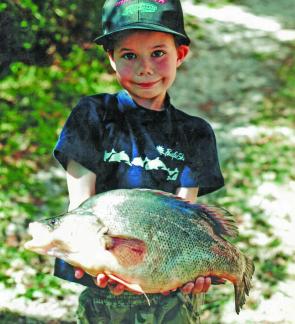
This great yellowbelly ate a shrimp suspended under a float. This fish fought hard up close to the surface.
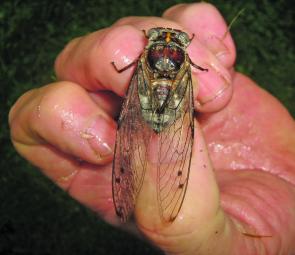
No better surface bait exists!

Cicadas taken from nearby trees make great bait for bass, cod and even yellowbelly. Especially if fluttering around alive on the surface, there is probably no better surface bait.
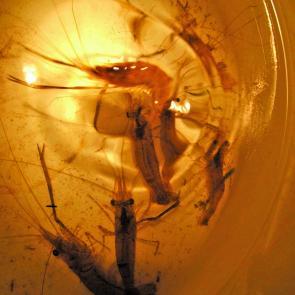
Shrimp are easy to catch and the kids can get involved. An old paint tin, billy or net trap baited with sweet corn and bread is all you need. They can also be netted in among weed in rivers.

A meaty freshwater mussel ready to go. Eels and catfish can be a problem because they seem to home in on mussels faster than yellowbelly or bass.

A piece of cut galvanised fencing and you have a very inventive rod holder to keep the gear out of the mud on the shores of a lake. Just remember to follow the rules on attended lines.

This small bass was taken from the bank at Glenbawn Dam on a hook full of worms right at the campground. Noise and disturbance from boats doesn’t necessarily put fish off the bite.
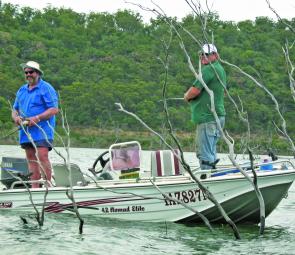
Anglers bob live yabbies for bass and yellowbelly right in the middle of a huge snag.
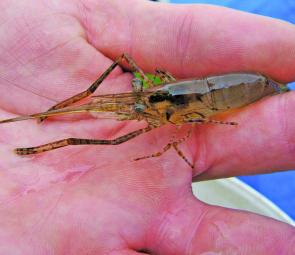
A freshwater shrimp has long arms and nippers, a prawn doesn’t.

This yellowbelly took a live yabby dropped to the bottom right at the edge of a huge weed bed in 15m of water.




